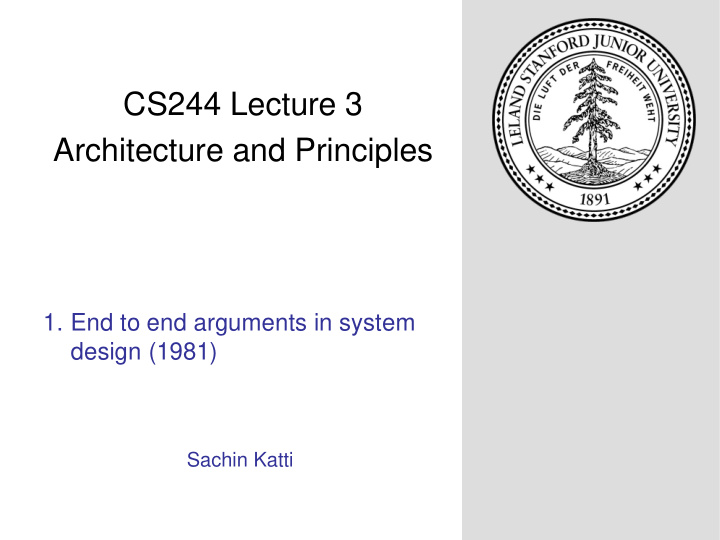



CS244 Lecture 3 Architecture and Principles 1. End to end arguments in system design (1981) Sachin Katti
End-to-End Arguments in System Design [Saltzer, Reed, Clark 1981] End-to-end in a nutshell “ The function in question can completely and correctly be implemented only with the knowledge and help of the application standing at the end points of the communication system. Therefore, providing that questioned function as a feature of the communication system itself is not possible. (Sometimes an incomplete version of the function provided by the communication system may be useful as a performance enhancement.) ” 2
Case studies 1. Error handling in file transfer 2. Encryption and authentication 1. WPA2 vs. TLS vs. PGP 3. The partition between TCP, IP, and the link layer of error handling, flow control and congestion control. 4. Fairness in resource allocation 5. Addressing 3
Some consequences • In layered design, the E2E principle provides guidance on where functions belong. • “ Dumb, minimal ” network and “ intelligent ” end- points. Many argue that: E2E principle allowed the Internet to grow rapidly because innovation took place at the edge, in applications and services. Ex. WWW, Skype, BitTorrent, Bitcoin 4
On the other hand… E2E principle appears to have become diluted: NATs, firewalls, VPN tunnel endpoints, … – Perhaps not surprising: E2E principle grew in an era of trust among users. Now network must protect itself . The network is no longer “ dumb, minimal ” – Now over 7,000 RFCs. – Router OS’s based on 100M lines of source code. Q: Is this a problem? 5
What belongs in, what out? Questions: • Does routing belong in the “ dumb, minimal ” network? •How about multicast, mobility, QoS…? • Are NATs necessary, good, or evil? • Is the E2E principle constraining innovation of the infrastructure? 6
Additional references [rfc3724] “ The Rise of the Middle and the Future of End-to-End: Reflections on the Evolution of the Internet Architecture ” - Kempf et al. [Blumenthal] “ Rethinking the design of the Internet: The end-to-end arguments vs. the brave new world ” , ACM Transactions on Internet Technology, Vol. 1, No. 1, August 2001, pp 70-109. 7
Recommend
More recommend